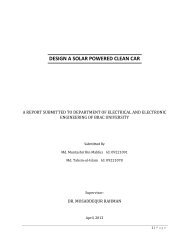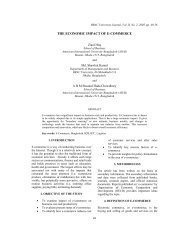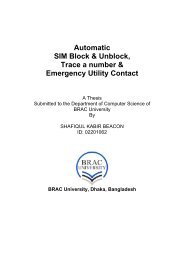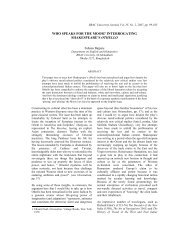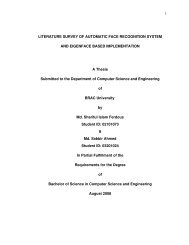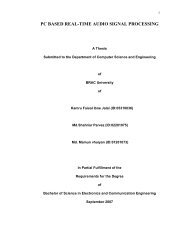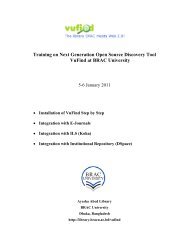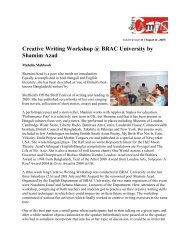design and simulation of a solar pv system - BRAC University ...
design and simulation of a solar pv system - BRAC University ...
design and simulation of a solar pv system - BRAC University ...
Create successful ePaper yourself
Turn your PDF publications into a flip-book with our unique Google optimized e-Paper software.
2.5 Types <strong>of</strong> <strong>solar</strong> <strong>system</strong> <strong>design</strong>:<br />
There can be various types <strong>of</strong> <strong>solar</strong> <strong>system</strong> <strong>design</strong>. But there are three basic <strong>design</strong><br />
consideration, they are-<br />
1. Grid tie<br />
2. Off-grid<br />
3. St<strong>and</strong> alone<br />
3.0 Solar PV technologies<br />
With the growing dem<strong>and</strong> <strong>of</strong> <strong>solar</strong> power new technologies are being introduced <strong>and</strong><br />
existing technologies are developing. There are four types <strong>of</strong> <strong>solar</strong> PV cells:<br />
� Single crystalline or mono crystalline<br />
� Multi- or poly-crystalline<br />
� Thin film<br />
� Amorphous silicon<br />
Single-crystalline or mono crystalline: It is widely available <strong>and</strong> the most efficient cells<br />
materials among all. They produce the most power per square foot <strong>of</strong> module. Each cell<br />
is cut from a single crystal. The wafers then further cut into the shape <strong>of</strong> rectangular cells<br />
to maximize the number <strong>of</strong> cells in the <strong>solar</strong> panel.<br />
Polycrystalline cells: They are made from similar silicon material except that instead <strong>of</strong><br />
being grown into a single crystal, they are melted <strong>and</strong> poured into a mold. This forms a<br />
square block that can be cut into square wafers with less waste <strong>of</strong> space or material than<br />
round single-crystal wafers.<br />
Thin film panels: It is the newest technology introduced to <strong>solar</strong> cell technology.<br />
Copper indium dieseline, cadmium telluride, <strong>and</strong> gallium arsenide are all thin film<br />
materials. They are directly deposited on glass, stainless steel, or other compatible<br />
substrate materials. Some <strong>of</strong> them perform slightly better than crystalline modules under<br />
low light conditions. A thin film is very thin-a few micrometer or less.<br />
Amorphous Silicon: Amorphous silicon is newest in the thin film technology. In this<br />
technology amorphous silicon vapor is deposited on a couple <strong>of</strong> micro meter thick<br />
amorphous films on stainless steel rolls. [13] Compared to the crystalline silicon, this<br />
technology uses only 1% <strong>of</strong> the material.<br />
Table 1 below shows the efficiency <strong>of</strong> different types <strong>of</strong> <strong>solar</strong> cells.<br />
11




